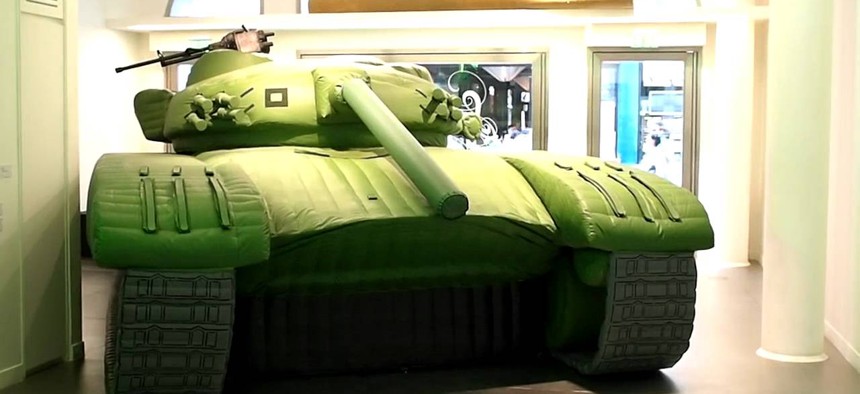Potemkin Jets Unlikely To Fool U.S. Satellites
But Russia’s inflatable decoys just might tie up scarce U.S. resources long enough to make a difference.
According to legend, in 1787, Crimean governor Grigory Potemkin created fake houses along the banks of the Dnieper River to impress Russian Empress Catherine the Great, giving rise to the phrase “Potemkin village.” Today Russia appears to be attempting something similar, with giant balloons made to look like tanks and jets. The audience, this time, appears to be the West. So would Potemkin MIGs actually work? Experts say: kinda.
The balloon decoys come from a Russian company called Rusbal, which sells “Life-sized air models of military machines and armour...designed for imitating various objects and creating fake military bases and positions of forces.”
This cheery commercial video explains, in Russian.
The New York Times reported this week that the balloons were part of the “Russian military’s longtime interest in operations of deceit and disguise, a repertoire of lethal tricks known as maskirovka, or masking. It is a psychological warfare doctrine that is becoming an increasingly critical element in the country’s geopolitical ambitions.”
Sure, but balloons? Modern hyperspectral imaging, of the sort captured by the DigitalGlobe’s WorldView 3 satellite, can easily tell a balloon from a real jet. Hyper and so-called superspectral imaging captures light in hundreds of wavelengths both visible and invisible. You can use that to understand the material composition of objects from space, including plastic.
“Camouflage is typically plasticized so we can see that,” says one industry intelligence analyst. The analyst, who is not with DigitalGlobe, spoke on condition of anonymity because they had not received clear authorization from the military to speak to the press. “Some modern camouflage was developed to defeat multispectral systems, but not” the WorldView 3, said the analyst.
“I suspect that current [U.S. government] assets have the ability to discriminate at a very fine resolution. The National Reconnaissance Office should have it covered,” said Thomas Snitch, a former arms control official and satellite imaging expert .
So if U.S. satellites can tell a real jet from a Potemkin one, what possible value could there be in deploying fakes? The answer: to tie up scarce U.S. resources. There aren’t that many such satellites, hyperspectral imaging is also data-intensive, and the process requires attention from human analysts.
“These sensors have a higher data volume (you basically need to have the sensor simultaneously acquire tens of hundreds of images of the same ground area), the area over which they can acquire data is less. So there is a tradeoff between spectral coverage and spatial coverage, and decoys like this can help exploit this tradeoff,” said Bradley J. Thomson, a professor of Earth and planetary sciences at the University of Tennessee.
Snitch says the value of the decoys would decrease exponentially as analysts figure out how and where Russia might use them. “The simple fact that the Russians have probably deployed a number of decoys, possibly around real armaments, will make the US look at them more frequently. It will not take long to notice the lack of people or support equipment around the decoys. If you image the area more than once a day, I would surmise that the analysts will quickly deduce that something is fishy,” he said.








